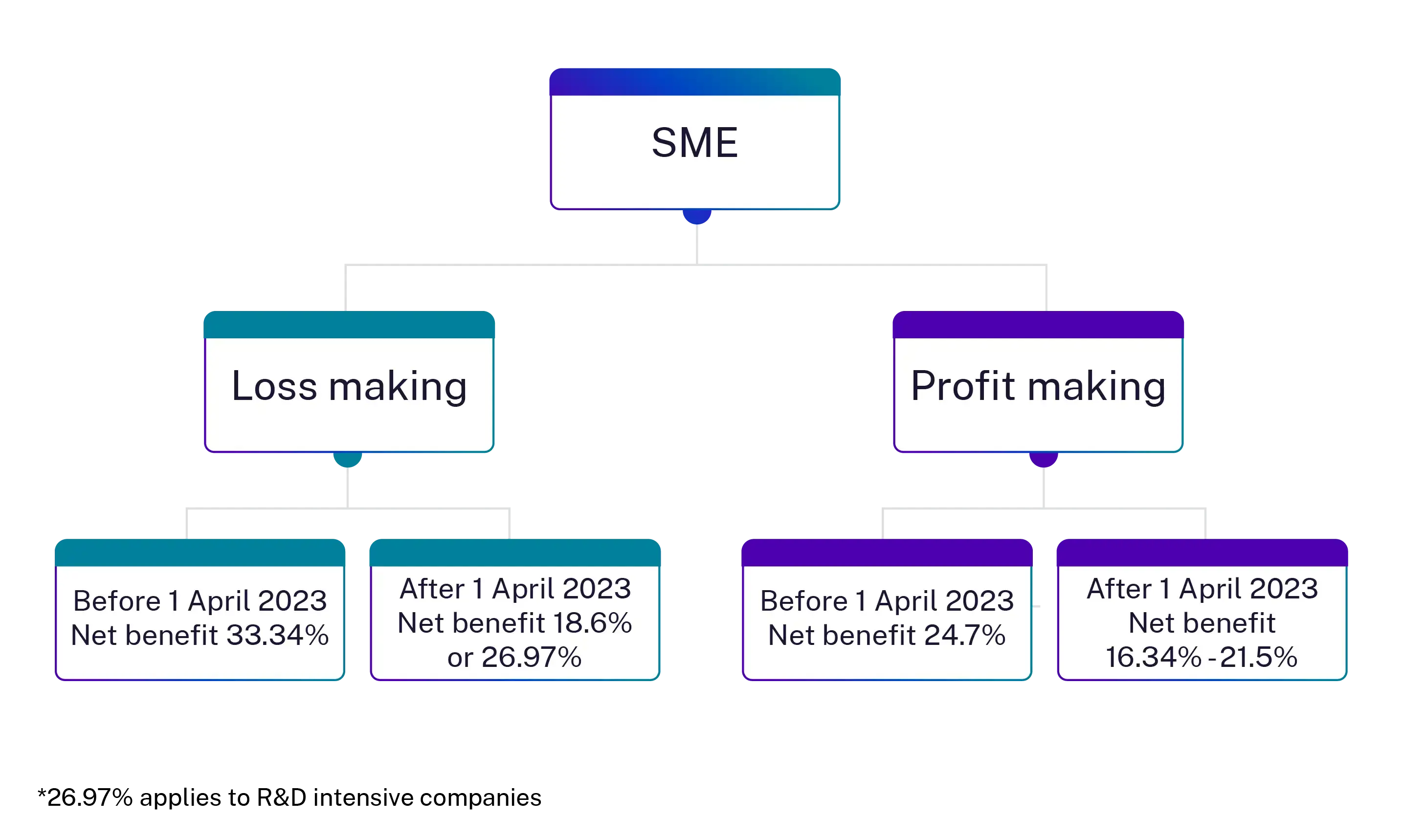R&D tax relief for SMEs

A company is classed as an SME if it has:
- total staff of fewer than 500 people and
- a turnover of less than €100 million or balance sheet assets of less than €86 million
Connected companies may need to have their figures included for assessing SME thresholds, depending on the connected company’s classification:
- Autonomous – where no external corporate entity owns 25% or more of its shares, and if it does not own 25% or more of any other company
- Linked enterprise – able to exercise control over the affairs of the other company, usually through holding greater than 50% of company voting rights
- Partner enterprise – not linked, but holds between 25% and 50% of voting rights
R&D relief qualifying costs
Various costs can qualify for relief:
- Staffing costs (including gross salaries, wages, overtime pay, and cash bonuses), employer national insurance contributions and employer pension contributions
- Subcontractor payments for activities part of the company’s R&D. The subcontractor’s activities need not be R&D considered in isolation as long as they are part of a larger R&D project. Subcontracted analytical testing, for example, may qualify. Only 65% of the total subcontractor costs can be eligble for R&D relief
- Costs of externally provided workers (EPWs), which are the staff costs paid to external agencies for workers directly and actively engaged in the R&D project. EPWs must carry out R&D activities under the claiming company’s supervision, direction or control. Only 65% of the total EPW costs can qualify for R&D relief
- Consumables, which are materials consumed or transformed in the R&D process, including utilities such as water, fuel, and power
- Software, including the cost of software licences used in the R&D activities
- Data licences and cloud computing utilised in the R&D activities
R&D relief benefits
SME R&D reliefs can benefit your business, whether it makes a profit or loss.
- SMEs can deduct extra qualifying costs from their yearly profit
- If the company makes a loss, it can claim a tax credit worth a proportion of the loss that can be surrendered
The rates of the enhanced deduction and tax credit changed from 1 April 2023.
| Enhanced deduction | Credit (in lieu of surrenderable losses) | |
| Before 1 April 2023 | 130% | 14.5% |
| After 1 April 2023 | 86% |
10% |
| After 1 April 2023 (R&D intensive loss-making companies)* | 86% | 14.5% |
*There is an increased R&D tax credit of 14.5% for R&D intensive loss-making SMEs with qualifying R&D expenditure worth 40% or more of total expenditure for an accounting period. This will only be applicable once legislated.

For companies making a profit
SME R&D relief allows companies to deduct extra qualifying costs from their profit for tax purposes.
Before 1 April 2023, an extra 130% of qualifying costs can be deducted and the net benefit (at a 19% corporation tax rate) is therefore 24.7% of the qualifying R&D expenditure.
After 1 April 2023, an extra 86% of qualifying costs can be deducted, and the net benefit (at a 19% - 25% corporation tax rate) is therefore 16.3% - 21.5% of the qualifying R&D expenditure.
In some cases, the net benefit received may be lower when the enhanced deduction takes a company from a taxable profit to a taxable loss position.
| Before 1 April 2023 | After 1 April 2023 (profits greater than £250,000) | |
| Trade profits | £1,000,000 | £1,000,000 |
| Corporate tax liability | £1,000,000 x 19% £190,000 |
£1,000,000 x 25% £250,000 |
| Qualifying R&D expenditure | £100,000 | £100,000 |
| Enhanced deduction | £100,000 x 130% £130,000 |
£100,000 x 86% £86,000 |
| Net tax benefit | £130,000 x 19% £24,700 |
£86,000 x 25% £21,500 |
From 1 April 2023, companies with profits lower than £250,000 can claim marginal relief. This will result in a marginal tax rate of between 19% and 25% and affect the SME R&D relief net benefit.
For companies making a loss, SME R&D relief allows them to claim a tax credit as a percentage of its loss that can be surrendered.
The surrenderable loss is equal to the lesser of:
- The unrelieved trading losses
- The qualifying expenditure plus the enhanced deduction
| Before 1 April 2023 | After 1 April 2023 | |
| Trade profits/(loss) | £1,000,000 | £1,000,000 |
| Corporate tax liability | £0 | £0 |
| Qualifying R&D expenditure | £100,000 | £100,000 |
| Enhanced deduction | £100,000 x 130% £130,000 |
£100,000 x 86% £86,000 |
The enhanced R&D deduction is subtracted from trading profits to give the unrelieved trading loss in the period. SME R&D relief allows companies to surrender losses in exchange for a cash credit.
| Before 1 April 2023 | After 1 April 2023 | After 1 April 2023 (R&D intensive companies)* | |
|
Surrenderable loss is the lesser of:
|
£1,130,000 £100,000 x 230% £230,000 |
£1,086,000 £100,000 x 186% £186,000 |
£1,086,000 £100,000 x 186% £186,000 |
| R&D tax credit Cash credit rate x Surrenderable loss |
14.5% x 230,000 £33,350 |
10% x 186,000 £18,600 |
14.5% x £186,000 £26,970 |


